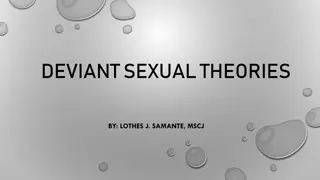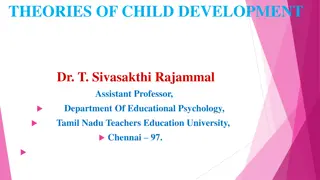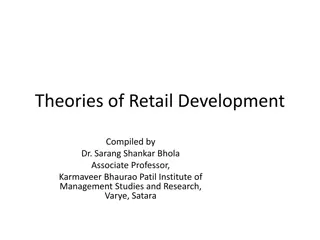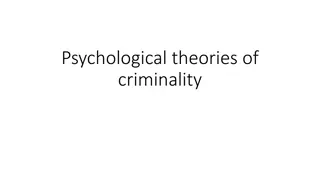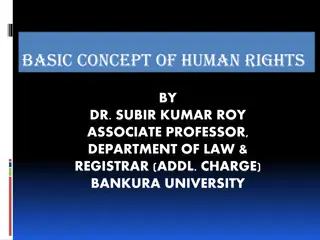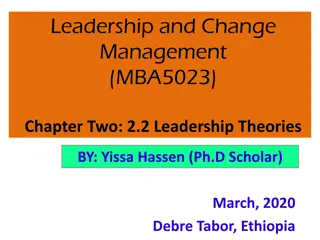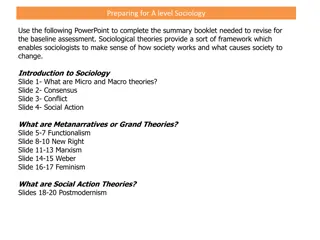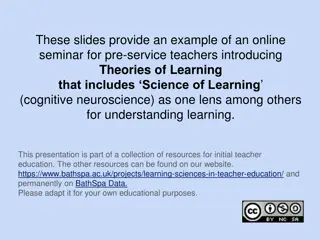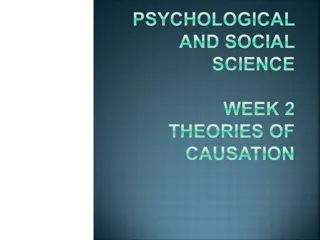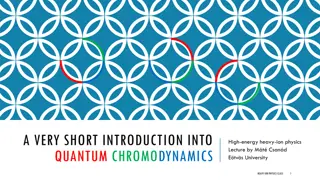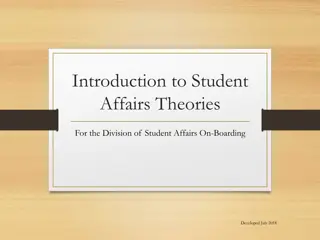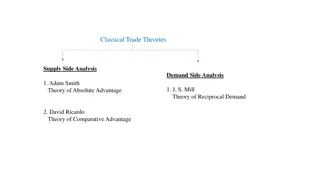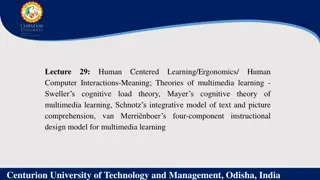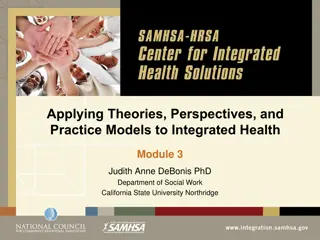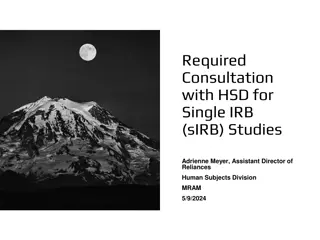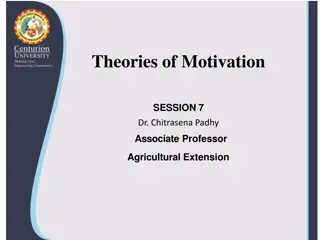
Theories of Human Development: Sensorial and Perceptual Development in Children
Explore the fascinating world of sensorial and perceptual development in children, delving into how our senses shape our understanding of the environment. Dive into the progression of sensory experiences from infancy, highlighting the importance of touch, taste, smell, sight, and hearing. Witness the intricate journey of perceptual development as babies refine their senses to interpret the world around them, paving the way for cognitive growth and understanding.
Download Presentation

Please find below an Image/Link to download the presentation.
The content on the website is provided AS IS for your information and personal use only. It may not be sold, licensed, or shared on other websites without obtaining consent from the author. If you encounter any issues during the download, it is possible that the publisher has removed the file from their server.
You are allowed to download the files provided on this website for personal or commercial use, subject to the condition that they are used lawfully. All files are the property of their respective owners.
The content on the website is provided AS IS for your information and personal use only. It may not be sold, licensed, or shared on other websites without obtaining consent from the author.
E N D
Presentation Transcript
HSD L4 TOPIC 2 MALUTI TVET BETHLEHEM Mrs C Schnetler
Theories of Human Development SENSORIAL AND PERCEPTUAL DEVELOPMENT: SENSORIAL DEVELOPMENT REFERS TO THE DEVELOPMENT OF OUR SENSES HUMAN BEINGS HAVE FIVE SENSES: SIGHT (VISION), SMELL (OLFACTORY), HEARING (AUDITIVE), TASTE AND TOUCH (TACTILE).
Theories of human development WE EXPERIENCE THE WORLD THROUGH OUR SENSES. THE CENTRAL NERVOUS SYSTEM ENABLES US TO INTERPRET OUR SENSORY EXPERIENCES. OUR NERVES CARRY INFORMATION FROM OUR ORGANS (EYES, EARS, NOSES, TONGUES, SKIN) TO OUR BRAINS THROUGH THE SPINAL CHORD. TOUCH IS THE FIRST SENSE TO DEVELOP: BABIES IN THE WOMB RESPOND TO SENSATIONS AROUND THEIR LIPS. SENSES DEVELOP DURING PRE-NATAL LIFE. BABIES MOVE THEIR EYES AND HEADS TOWARDS CERTAIN SOUNDS AND LIGHT. EVEN VERY YOUNG INFANTS ARE SENSITIVE TO A RANGE OF STIMULI. BABIES PREFER SWEET TASTES TO ANYTHING BITTER OR SALTY. THE COLOUR RED IS THE MOST ATTRACTIVE COLOUR TO NEW BORN BABIES. BABIES USE SMELL TO DISTINGUISH THEIR MOTHER S BREAST FROM THAT OF ANOTHER MOTHER. BABIES ARE MOST ATTRACTED TO SOUNDS THAT ARE MOST LIKE THE HUMAN VOICE. AS BABIES GROW INTO CHILDREN, THEY INCREASINGLY USE THEIR SENSES TO UNDERSTAND THE WORLD.
Theories of human development PERCEPTUAL DEVELOPMENT REFERS TO THE INTERPRETATION OF INFORMATION GAINED THROUGH OUR SENSES. AS THE BABIES SENSES BECOME MORE REFINED, THEY ARE BETTER ABLE TO USE THEM TO INTERPRET THEIR ENVIRONMENT. THEY START TO USE SENSORY INFORMATION TO UNDERSTAND THE WORLD THIS IS PERCEPTUAL DEVELOPMENT.
Theories of human development SIGHT/VISION: DURING THE FIRST 6 MONTHS, THE VISION OF THE INFANT IMPROVES RAPIDLY. BEFORE THEY ARE 1 WEEK OLD, THEY FOCUS THEIR SIGHT ON THE HUMAN FACE RATHER THAN ON OTHER OBJECTS. BY 2 MONTHS, THEY CAN USUALLY SEE THE DIFFERENCE BETWEEN PEOPLE S FACES BY LOOKING AT THEIR NOSES, EYES AND MOUTHS. AT 3 MONTHS, THEY RECOGNISE THEIR MOTHERS FACE AT 3 MONTHS, SOME BABIES EVEN RECOGNISE AND IMITATE FACIAL EXPRESSIONS SUCH AS FROWNING AND SMILING.
Theories of human development Most babies can distinguish between male and female features. Infants use their sense of sight to understand their interactions with the people around them, and to recognise who the most important people are. By 5, their vision will have fully developed. Most babies can distinguish between male and female features. Infants use their sense of sight to understand their interactions with the people around them, and to recognise who the most important people are. By 5, their vision will have fully developed.
Theories of human development HEARING: VERY YOUNG BABIES ARE RECEPTIVE TO THE SOUNDS OF HUMAN SPEECH. THEY ARE SENSITIVE TO THE TONES, RHYTHM, AND THE INDIVIDUAL SOUNDS THAT LANGUAGE CONSISTS OF. BEFORE THEY ARE 1, THEY CAN HEAR THE SUBTLE DIFFERENCE BETWEEN SOUNDS LIKE BA AND PA . WHEN THEY ARE OLDER THAN 1 YEAR, THEY LOSE THE ABILITY TO HEAR THE DIFFERENCE.
Theories of human development PERCEPTUAL DEVELOPMENT OF YOUNG BABIES INVOLVES A CONNECTION BETWEEN THEIR HEARING AND THEIR VISION. BABIES LEARN TO CONNECT THE MOVEMENTS OF A PERSON S MOUTH WITH THE SOUNDS THAT COME OUT OF THEM; THUS, THEY CAN CONNECT VISUAL STIMULI WITH AUDITORY STIMULI IN ORDER TO RELATE P PEOPLE TALKING TO THEM. COGNITIVE DEVELOPMENT: SENSORY INFORMATION IS VERY IMPORTANT FOR COGNITIVE DEVELOPMENT. COGNITIVE DEVELOPMENT REFERS TO THE DEVELOPMENT OF THOUGHT PROCESSES AND TO THE BRAIN.
Theories of human development PHYSICAL CHANGES OF THE BRAIN: WHEN A BABY IS BORN, ITS BRAIN IS OF THE SIZE IT WILL BE AS AN ADULT. BY 2, THE BRAIN IS THE SAME SIZE AS IT WILL BE WHEN AN ADULT. GROWTH IN BRAIN SIZE IN THE FIRST 2 YEARS IS MASSIVE AND RAPID. DURING THE FIRST YEAR, THE BRAIN BECOMES 3 X HEAVIER THAN IT WAS AT BIRTH. THE RAPID BRAIN GROWTH IS UNIQUE TO HUMAN BEINGS AS MAMMALS. THE BRAIN IS ABOUT 2% OF THEIR BODY WEIGHT. HUMANS ARE BORN WITH THE MAXIMUM NUMBER OF NEURONS WE CANNOT GROW MORE NEURONS OR BRAIN CELLS. NEW CONNECTIONS BETWEEN NEURONS CAN BE FORMED AS WE DEVELOP, THUS: BRAIN DEVELOPMENT AFTER 2, MEANS THE ESTABLISHMENT AND STRENGTHENING OF CONNECTIONS OR PATHWAYS BETWEEN NEURONS IN THE BRAIN. WHILE NEW NEURONS ARE NOT FORMED AFTER BIRTH, THOUSANDS OF NEURONS DIE IN THE BRAIN EVERY DAY: - BY 75, THE WEIGHT OF THE BRAIN HAS DECREASED BY 10 %. - THIS LOSS OF WEIGHT DOES NOT NECESSARILY LEAD TO A LOSS OF FUNCTION, BUT BRAIN ACTIVITY DOES DECLINE STEADILY FROM YOUNG ADULTHOOD UNTIL OLD AGE.
Theories of human development PLEASE REFER TO P. 78 80 FOR THE CASE STUDY ON IRON DEFICIENCY. CONCLUSIONS ON THE CASE STUDY MENTIONED ABOVE: NO SINGLE THING IN THE HUMAN S ENVIRONMENT ALONE AFFECTS PSYCHOMOTOR DEVELOPMENT IN THE FIRST CYCLE OF LIFE. IT SHOWS A COMBINATION OF FACTORS: YOUNG MOTHER WHO IS IRON DEFICIENT, HAVING BAD RELATIONSHIP WITH PARTNER, CAN NEGATIVELY IMPACT PSYCHOMOTOR DEVELOPMENT. THE DEVELOPMENTAL TEST SCORES OF BABIES WHOSE MOTHERS WERE IRON DEFICIENT, WERE SIGNIFICANTLY WORSE THAN BABIES WHOSE MOTHERS IRON STATUS WAS NORMAL. THE MOTHER S IRON STATUS COULD AFFECT MOTHER-INFANT INTERACTION: - MOTHERS WHO WERE FEELING DEPRESSED AND TIRED BECAUSE OF IRON DEFICIENCY, COULD BEHAVE MORE NEGATIVELY TOWARD THEIR BABIES THAN MOTHERS WHO WERE NOT IRON DEFICIENT. THE NEGATIVE BEHAVIOUR MIGHT HAVE NEGATIVELY AFFECTED THEIR BABIES DEVELOPMENT.
Theories of human development RELEVANT QUESTIONS: 1. LIST FIVE STAGES OF HUMAN DEVELOPMENT. 2. DISCUSS THE NURTURE VS NATURE DEBATE. 3. DEFINE AND DISCUSS EACH OF THE FOLLOWING: THE CENTRAL NERVOUS SYSTEM MOTOR DEVELOPMENT SENSORIAL DEVELOPMENT PERCEPTUAL DEVELOPMENT BRAIN DEVELOPMENT - GROSS MOTOR SKILLS FINE MOTOR SKILLS 5. NAME THE MILESTONES OF THE WHO FOR BABIES. - - - - - -

